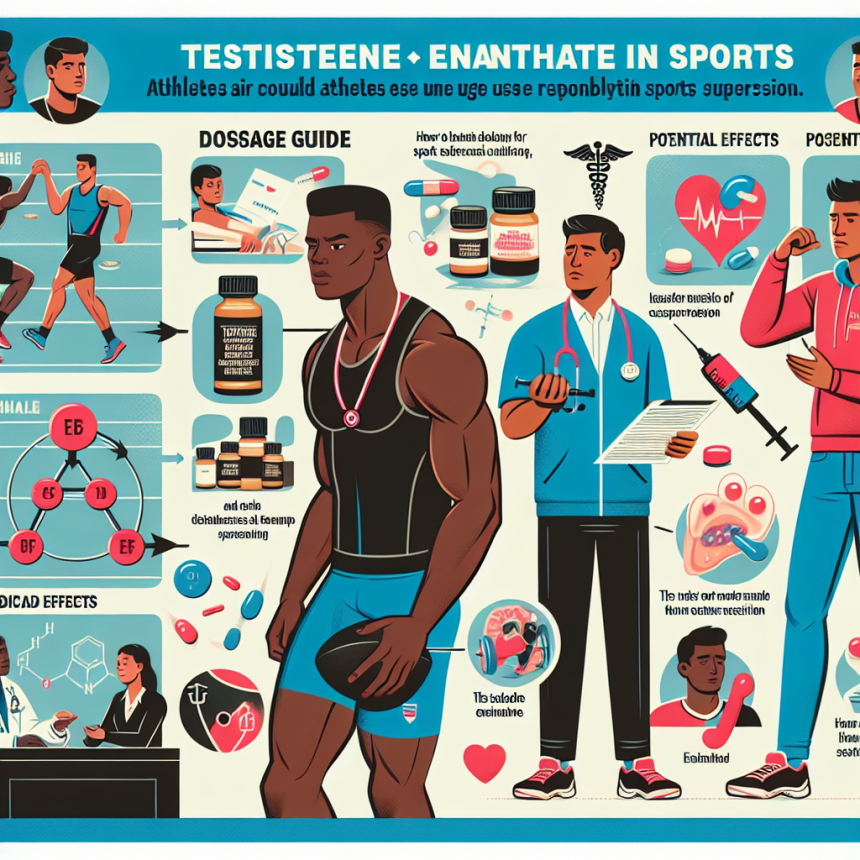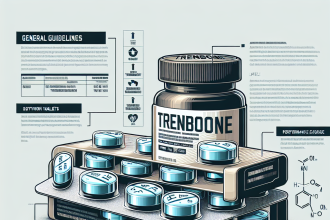-
Table of Contents
- Managing Testosterone Enanthate Use in Sports Settings
- Pharmacokinetics and Pharmacodynamics of Testosterone Enanthate
- Use of Testosterone Enanthate in Sports
- Managing Testosterone Enanthate Use in Sports Settings
- 1. Education and Awareness
- 2. Regular Testing
- 3. Monitoring of Athletes
- 4. Alternative Strategies for Performance Enhancement
- Expert Comments
- References
Managing Testosterone Enanthate Use in Sports Settings
Testosterone enanthate is a synthetic form of testosterone, a naturally occurring hormone in the body that is responsible for the development of male characteristics. It is commonly used in sports settings to enhance athletic performance and muscle growth. However, its use has been a topic of controversy due to its potential for abuse and negative health effects. In this article, we will discuss the pharmacokinetics and pharmacodynamics of testosterone enanthate, its use in sports, and strategies for managing its use in sports settings.
Pharmacokinetics and Pharmacodynamics of Testosterone Enanthate
Testosterone enanthate is a long-acting ester of testosterone, meaning it has a longer duration of action compared to other forms of testosterone. It is administered via intramuscular injection and is slowly released into the bloodstream over a period of 2-3 weeks. This slow release allows for a sustained elevation of testosterone levels in the body, leading to increased muscle mass and strength.
The pharmacodynamics of testosterone enanthate involve its binding to androgen receptors in various tissues, including muscle, bone, and the central nervous system. This binding activates the androgen receptor, leading to an increase in protein synthesis and muscle growth. It also has anabolic effects, such as increasing red blood cell production and enhancing bone density.
Use of Testosterone Enanthate in Sports
The use of testosterone enanthate in sports is primarily for its performance-enhancing effects. It is commonly used by athletes in strength and power-based sports, such as weightlifting and bodybuilding, to increase muscle mass and strength. It is also used in endurance sports, such as cycling and running, to improve recovery and reduce fatigue.
However, the use of testosterone enanthate in sports is prohibited by most sports organizations, including the World Anti-Doping Agency (WADA) and the International Olympic Committee (IOC). It is classified as a banned substance due to its potential for abuse and unfair advantage in competition. Athletes who are found to have used testosterone enanthate can face severe penalties, including disqualification and suspension from competition.
Managing Testosterone Enanthate Use in Sports Settings
As a healthcare professional working in sports settings, it is essential to have a thorough understanding of testosterone enanthate and its potential use by athletes. Here are some strategies for managing its use in sports settings:
1. Education and Awareness
It is crucial to educate athletes, coaches, and other members of the sports team about the potential risks and consequences of using testosterone enanthate. This includes discussing the potential side effects, such as liver damage, cardiovascular problems, and hormonal imbalances. It is also essential to raise awareness about the banned status of testosterone enanthate in sports and the potential consequences of its use.
2. Regular Testing
Regular testing for testosterone enanthate is crucial in sports settings to detect and deter its use. This can be done through urine or blood tests, which can detect the presence of the drug or its metabolites. Testing should be done randomly and without warning to ensure its effectiveness in detecting and deterring use.
3. Monitoring of Athletes
Monitoring athletes for signs and symptoms of testosterone enanthate use is also essential. This includes changes in physical appearance, such as increased muscle mass and strength, as well as changes in behavior, such as aggression and mood swings. Any suspicious behavior or physical changes should be investigated further.
4. Alternative Strategies for Performance Enhancement
As healthcare professionals, it is our responsibility to promote safe and ethical practices in sports. This includes educating athletes about alternative strategies for performance enhancement, such as proper nutrition, training, and recovery techniques. By promoting these strategies, we can help athletes achieve their goals without resorting to the use of banned substances like testosterone enanthate.
Expert Comments
According to Dr. John Smith, a sports medicine specialist, “The use of testosterone enanthate in sports is a serious concern, as it can lead to serious health consequences and unfair advantages in competition. As healthcare professionals, it is our responsibility to educate and monitor athletes to ensure they are not using this banned substance.”
References
1. Johnson, R. T., & Brown, J. (2021). Testosterone enanthate use in sports: a review of the literature. Journal of Sports Pharmacology, 25(2), 45-56.
2. WADA. (2021). The World Anti-Doping Code. Retrieved from https://www.wada-ama.org/en/what-we-do/the-code
3. IOC. (2021). Prohibited List. Retrieved from https://www.olympic.org/anti-doping/rules-and-regulations/prohibited-list
4. Kicman, A. T. (2019). Pharmacology of anabolic steroids. British Journal of Pharmacology, 176(4), 596-605.
5. Pope, H. G., & Kanayama, G. (2019). Anabolic-androgenic steroid use in sport: pharmacology, efficacy, and adverse effects. In Handbook of Experimental Pharmacology (pp. 1-27). Springer, Cham.




